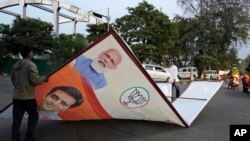Indian general elections, in which Prime Minister Narendra Modi is seeking a third term, will be held over six weeks starting April 19, India’s Election Commission said Saturday.
Billed as the world’s largest democratic exercise, nearly 1 billion voters will be eligible to choose the 543 elected members of the House of the People, the lower house of the Parliament; two other seats are appointed by the president. The election will be held in seven phases until June 1, and votes will be counted on June 4.
India’s elections are staggered over several weeks to allow security forces to move around the country.
The polls pit Modi’s Bharatiya Janata Party and its regional allies against a political alliance called INDIA, which has been forged by the main opposition Congress and more than two dozen regional parties. Surveys in recent weeks have forecast an easy victory for the BJP, as Modi continues to remain India’s most popular leader in decades.
Since sweeping to power a decade ago, he has consolidated his hold on the country with a focus on economic growth and an appeal to muscular Hindu nationalism.
Modi unveiled a grand temple dedicated to Hindu god Rama in January on a site where a mosque was destroyed three decades ago. The opening of the temple helped galvanize his base among Hindu voters ahead of elections.
The country has been in election mode for several weeks, with Modi and opposition leaders going around the country to connect with voters. At a series of public meetings he has held in recent weeks, Modi has reiterated his resolve to make India a developed nation by 2047 and unveiled massive infrastructure projects.
The opposition has flagged such concerns as unemployment and inflation, and it says much of India’s economic growth has benefitted big businesses and not improved the lot of the masses.
The Congress Party, the main challenger to the BJP, has been trounced in the last two elections but hopes to mount a more credible challenge to Modi by joining hands with regional parties.
The alliance formed to counter Modi is struggling to hold together.
One of its main allies has deserted it and joined hands with the BJP, while some parties have chosen to contest the polls on their own rather than nominate common candidates to fight the BJP.
“These elections are very consequential for India,” said political analyst Rasheed Kidwai. “If the opposition fares poorly and the BJP has a huge majority, then democracy as such will not be the same. Accountability and pressure on the ruling party will go away.”
The BJP is upbeat about its electoral prospects and has set a target of winning 370 seats on its own and upwards of 400 with its allies.
The polls are being held months after it won massive victories in the country’s Hindi-speaking heartland that plays a crucial role in shaping national poll results. It wrested control of two states, Rajasthan and Chhattisgarh, from the main opposition Congress Party while retaining power in another, Madhya Pradesh.
A day before the election announcement, Modi said in an open letter to Indians that “our partnership is at the threshold of completing a decade” and “I am confident we will continue to take our nation to great heights together.”
At a press conference to announce the election schedule, the Election Commission, which organizes the polls, outlined the mammoth scale of the exercise.
“The number of voters in India, 978 million, is more than the combined voters in some continents like Europe and Australia and countries like the United States,” Chief Election Commissioner Rajiv Kumar said.
He said that more than 1 million voting booths will be set up throughout the country and that efforts will be made to ensure that voters in remote places can cast ballots.
“We will take democracy to every corner of the country,” Kumar said. “Our teams will walk the extra mile to reach every voter, whether they are in jungles, on snowy mountains. We will go on horseback, elephants, mules or helicopters. We will reach everywhere.”
In the country with the youngest population in the world, 18 million people will vote for the first time.
With improving voter turnout, officials said one of the goals of the commission is to organize voter awareness programs in areas that have had a low turnout in the past. The 2019 elections registered a record turnout of 67%.
As election disinformation emerges as a concern worldwide, the commission will also set up control rooms to spot fake content on social media.








